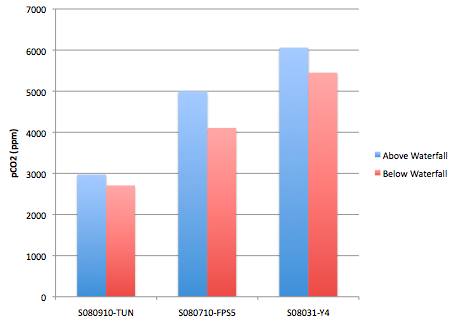After collecting some pretty interesting data from the tundra, I decided it was time to share a bit about my project. As part of the stream team, my project is aimed at answering a simple question: are small arctic streams sources of CO2 to the atmosphere?
To address this question, I needed to measure the concentration of dissolved CO2 (partial pressure of CO2 or pCO2) in the stream sites I visited. If the concentrations of CO2 are high enough above atmospheric levels (~390 parts per million), then CO2 naturally evades from the stream to the atmosphere due to the concentration gradient. To take this one step further, I measured longitudinally along the stream to see if I could detect a loss of CO2 as I moved downstream. In other words, I wanted to directly measure the degassing of CO2 from the stream to atmosphere.
This figure encapsulates some of the trends I’ve been finding:
It shows three sites that shared a definitive waterfall feature where water flowing through the channel dropped abruptly ~.5-1 meters. The turbulence of such a feature allows CO2 to escape from the stream water to the atmosphere. Sure enough, after measuring the CO2 directly above and below the waterfalls, each stream showed a significant decline in dissolved CO2. I should note that most of the streams I have sampled have showed this loss of CO2 generally, measured over the course of the stream. They have also showed very high levels of CO2, some as high as 18,000 ppm (46 times atmospheric).
Aside from degassing, the only other mechanism for a loss in CO2 is through photosynthesis by aquatic algae. Blaize and I conducted a 24-hour pCO2 survey of a nearby stream and found no diurnal trends in CO2 (if there had been photosynthesis, we would have expected a drop in CO2 during the brightest part of the day, when algae are receiving proper sunlight). Furthermore, the CO2 loss displayed in the figure above could not have been due to photosynthesis given the short distance over which the loss was measured. This leaves degassing as the primary loss of CO2 and implicates these small arctic streams as key components to the carbon cycle during the summer months.
More to come.
-Travis




